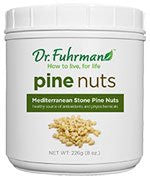-
Mediterranean Stone Pine Nuts (8 oz. Jar)
Dr Fuhrman
-
$55.48
-
is back-ordered. We will ship it separately in 10 to 15 days.
-
-
Description
There are over 100 species of pine trees, and 29 of these produce edible seeds, known as pine nuts. Most of the pine nuts available in the U.S. are harvested from pine trees that grow in China, Korea, or Mexico. Their nutritional composition of the pine nuts is quite different from the Mediterranean pine nuts; which are the seeds of the Stone Pine (Pinus pinea, also called the Umbrella Pine), which is native to Italy, Spain and Portugal. The Stone Pine is tall, reaching up to75 ft. in height, and the cones take longer to mature than any other pine. People of the Mediterranean region have been eating the nuts of Pinus pinea (also called pignolia) for thousands of years. (There is evidence that pignolia were eaten and used to make wine in ancient Rome). Pine nuts have exceptional nutritional value. They are rich sources of numerous health-promoting minerals, antioxidants, and phytochemicals. The pignolia of the Mediterranean region are nutritionally unique among pine nuts. The are lower in calories than other pine nuts. They have a favorable omega-3 to omega-6 ratio, almost ten times higher than other pine nuts. They contain high levels of cholesterol-lowering phytosterols. Pignolia tie with pistachios for the highest phytosterol content of all nuts. They contain more than twice the protein of other nuts including other pine nuts. This feature of pignolia makes them especially useful as a nutritional supplement for athletes, who have greater than average protein requirements. This is also useful for anyone who wants to add nutrient-rich calories to their diet without adding excessive fat. At 34 % protein by weight, Mediterranean pine nuts are richer in protein than an other plant food, including soybeans (10%), sesame seeds (18%), sunflower seeds (21%), and even hemp seeds (33%).

